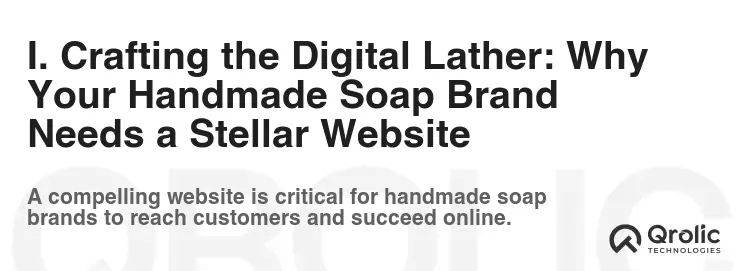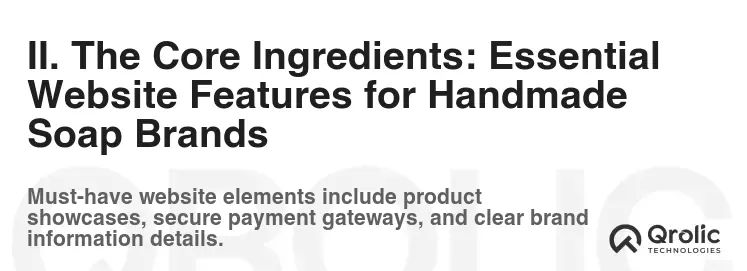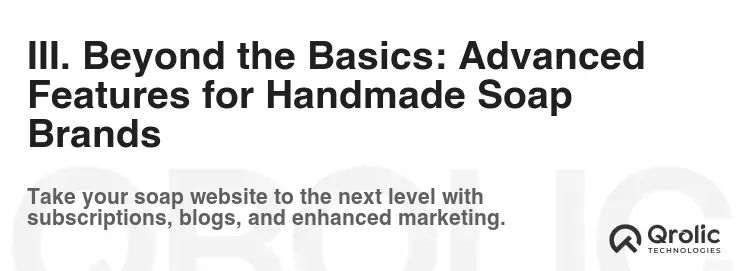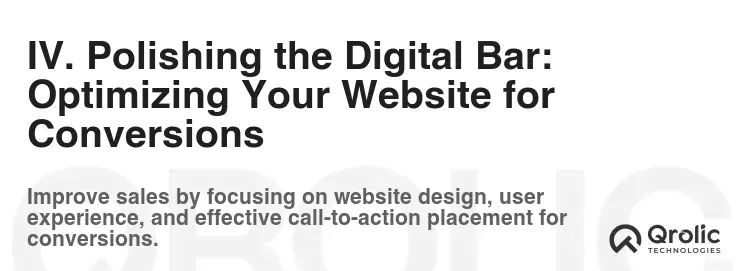Quick Summary:
- Showcase your soaps with stunning photos and clear details.
- Offer secure, easy online shopping with order tracking.
- Build trust: be transparent about ingredients and use reviews.
- Optimize your site for mobile, speed, and search engines.
Table of Contents
- I. Crafting the Digital Lather: Why Your Handmade Soap Brand Needs a Stellar Website
- A. Beyond the Brick-and-Mortar: Reaching a Wider Audience
- B. Building Brand Authority and Trust: Showcasing Your Expertise
- C. Streamlining Sales and Managing Orders: The Power of Ecommerce
- D. Mastering the First Impression: Website Design Essentials
- E. Staying Ahead of the Curve: The Importance of Mobile Optimization
- II. The Core Ingredients: Essential Website Features for Handmade Soap Brands
- A. The Showcase: High-Quality Product Pages
- 1. Captivating Product Photography: Visual Storytelling
- 2. Compelling Product Descriptions: Tell the Story of Your Soap
- 3. Ingredient Transparency: Building Trust Through Honesty
- 4. User Reviews and Ratings: Social Proof That Sells
- 5. Clear Pricing and Call-to-Action: Make it Easy to Buy
- 6. Variations and Options: Catering to Individual Preferences
- B. The Marketplace: Seamless Ecommerce Functionality
- 1. Secure Payment Gateway: Building Confidence in Transactions
- 2. Shopping Cart Functionality: A Smooth Path to Purchase
- 3. Order Tracking: Keeping Customers Informed
- 4. Inventory Management: Avoiding Overselling and Disappointment
- 5. Shipping Options and Rates: Transparency and Choice
- C. The Storyteller: Compelling Content and Branding
- 1. “About Us” Page: Connecting with Your Customers
- 2. Blog: Sharing Expertise and Building Community
- 3. “FAQ” Page: Answering Common Questions
- 4. Contact Information: Making it Easy to Connect
- D. The Navigator: User-Friendly Website Structure and Navigation
- 1. Clear and Intuitive Navigation Menu: Guiding Your Visitors
- 2. Search Functionality: Helping Customers Find Specific Products
- 3. Breadcrumb Navigation: Enhancing User Experience
- E. The Promoter: Marketing and SEO Integration
- 1. SEO Optimization: Making Your Website Visible
- 2. Social Media Integration: Connecting with Your Audience
- 3. Email Marketing: Building Relationships and Driving Sales
- 4. Analytics Tracking: Measuring Your Success
- III. Beyond the Basics: Advanced Features for Handmade Soap Brands
- A. Subscription Boxes: Recurring Revenue and Customer Loyalty
- B. Personalized Recommendations: Enhancing the Shopping Experience
- C. Loyalty Programs: Rewarding Your Best Customers
- D. Interactive Content: Engaging and Educating Your Audience
- E. Augmented Reality (AR) Experiences: Bringing Your Soaps to Life
- IV. Polishing the Digital Bar: Optimizing Your Website for Conversions
- A. A/B Testing: Experimenting for Optimal Performance
- B. Reducing Cart Abandonment: Recovering Lost Sales
- C. Mobile-First Design: Prioritizing the Mobile Experience
- D. Page Speed Optimization: Ensuring a Fast Loading Experience
- E. Customer Support: Providing Excellent Service
- V. The Future of Handmade Soap Ecommerce: Trends to Watch
- A. Voice Search Optimization: Adapting to New Technologies
- B. Artificial Intelligence (AI): Personalization and Automation
- C. Sustainable Practices: Appealing to Environmentally Conscious Consumers
- D. Local SEO: Connecting with Local Customers
- E. Video Marketing: Showcasing Your Craftsmanship
- VI. Building a Website: Choosing the Right Platform
- A. Shopify: Ecommerce Powerhouse
- B. WordPress with WooCommerce: Customizable and Flexible
- C. Squarespace: Visually Appealing and User-Friendly
- D. Etsy: Leveraging an Existing Marketplace
- VII. Qrolic Technologies: Your Partner in Digital Growth
- A. Website Design and Development: Crafting Your Online Identity
- B. Ecommerce Solutions: Streamlining Your Online Sales
- C. SEO and Digital Marketing: Driving Traffic to Your Website
- D. Content Creation: Telling Your Brand Story
- E. Website Maintenance and Support: Ensuring a Smooth Online Presence
- VIII. Conclusion: Soaping Up Success in the Digital Realm
I. Crafting the Digital Lather: Why Your Handmade Soap Brand Needs a Stellar Website

The scent of lavender and chamomile, the gentle swirl of color in a marbled bar, the satisfying lather that cleanses and soothes – these are the hallmarks of handmade soap. But in today’s competitive market, the artistry of your craft needs a digital stage. A website isn’t just an online brochure; it’s your virtual storefront, your brand ambassador, and your primary engine for driving sales. Let’s dive into why a strong website is essential and explore the key features that will set your handmade soap brand apart.
A. Beyond the Brick-and-Mortar: Reaching a Wider Audience
While farmers’ markets and local craft fairs offer a tactile experience, they limit your reach. A website transcends geographical boundaries, allowing you to connect with customers across the country, even the globe. This expanded reach dramatically increases your potential customer base.
B. Building Brand Authority and Trust: Showcasing Your Expertise
Your website is your opportunity to tell your story. Explain your soap-making process, highlight the natural ingredients you use, and share your passion for creating gentle, effective skincare. High-quality content, compelling visuals, and customer testimonials build trust and establish your brand as an authority in the handmade soap market.
C. Streamlining Sales and Managing Orders: The Power of Ecommerce
An ecommerce website allows you to sell your soaps directly to customers 24/7. Automated order processing, secure payment gateways, and integrated shipping options streamline the sales process, freeing up your time to focus on crafting exceptional products.
D. Mastering the First Impression: Website Design Essentials
Aesthetics matter. Your website’s design should reflect the natural, handcrafted quality of your soaps. A clean, uncluttered layout, high-quality product photography, and a user-friendly interface create a positive first impression and encourage visitors to explore your offerings. Think about incorporating earthy tones, natural textures, and imagery that evokes a sense of calm and well-being.
E. Staying Ahead of the Curve: The Importance of Mobile Optimization
More people are browsing the internet on their smartphones than ever before. A mobile-optimized website ensures that your site looks and functions flawlessly on all devices, providing a seamless shopping experience for every customer. Neglecting mobile optimization means potentially losing a significant portion of your audience.
II. The Core Ingredients: Essential Website Features for Handmade Soap Brands

Building a successful website for your handmade soap brand requires careful planning and the incorporation of essential features. Let’s examine the key components that will drive traffic, increase sales, and enhance customer satisfaction.
A. The Showcase: High-Quality Product Pages
Your product pages are the heart of your website. They’re where potential customers learn about your soaps and decide whether or not to make a purchase.
1. Captivating Product Photography: Visual Storytelling
Invest in professional product photography that showcases the unique colors, textures, and shapes of your soaps. Use a variety of angles and close-up shots to highlight the details. Consider including lifestyle images that show your soaps in use. For example, a bar of lavender soap could be pictured next to a luxurious bubble bath, or a bar of exfoliating soap could be shown in a natural bathroom setting. These images help customers visualize how your soaps can enhance their daily routine.
- Best Practices: Use high-resolution images, optimize images for web (reduce file size for faster loading), use consistent lighting and backgrounds, and include alt text for accessibility and SEO.
2. Compelling Product Descriptions: Tell the Story of Your Soap
Don’t just list ingredients. Tell the story of your soap. Describe the scent profile, the benefits for the skin, and the inspiration behind the creation. Use evocative language to paint a picture in the customer’s mind.
- Example: Instead of “Lavender Soap – Contains lavender essential oil, olive oil, and shea butter,” try: “Indulge in the calming embrace of our Lavender Dream Soap. Crafted with pure lavender essential oil, this gentle bar soothes both body and mind. Nourishing olive oil and creamy shea butter leave your skin feeling soft, supple, and delicately fragranced. Perfect for a relaxing evening bath or a refreshing morning shower.”
3. Ingredient Transparency: Building Trust Through Honesty
Customers are increasingly conscious of the ingredients in their skincare products. Provide a complete and accurate list of all ingredients used in your soaps. Highlight natural and organic ingredients to appeal to environmentally conscious consumers.
- Benefits: Demonstrates transparency, builds trust, and helps customers with allergies or sensitivities make informed decisions.
4. User Reviews and Ratings: Social Proof That Sells
Encourage customers to leave reviews and ratings on your product pages. Positive reviews provide social proof and can significantly influence purchasing decisions. Respond to reviews, both positive and negative, to show that you value customer feedback.
- Implementation: Use a review plugin or integrate a review platform with your website.
5. Clear Pricing and Call-to-Action: Make it Easy to Buy
Display pricing clearly and prominently on each product page. Use a clear and concise call-to-action button, such as “Add to Cart” or “Buy Now.” Ensure that the checkout process is simple and straightforward.
- Tip: Consider offering discounts or promotions to incentivize purchases.
6. Variations and Options: Catering to Individual Preferences
If you offer different sizes, scents, or formulations of the same soap, provide clear options for customers to choose from. Use dropdown menus or visual selectors to make it easy to customize their order.
- Example: Offer a lavender soap in a small travel size, a regular bar size, and a larger family size.
B. The Marketplace: Seamless Ecommerce Functionality
A robust ecommerce platform is the backbone of your online store.
1. Secure Payment Gateway: Building Confidence in Transactions
Integrate a secure payment gateway, such as PayPal, Stripe, or Square, to ensure that customer financial information is protected. Display security badges prominently on your website to reassure customers that their transactions are safe.
- Importance: Security is paramount. Customers need to feel confident that their personal and financial information is protected.
2. Shopping Cart Functionality: A Smooth Path to Purchase
Ensure that your shopping cart is easy to use and intuitive. Allow customers to easily add, remove, and adjust quantities of items in their cart. Provide clear information about shipping costs and estimated delivery times.
- Optimization: Minimize the number of steps required to complete a purchase. Offer guest checkout options for customers who don’t want to create an account.
3. Order Tracking: Keeping Customers Informed
Provide customers with order tracking information so they can monitor the progress of their shipments. This helps to reduce anxiety and improves customer satisfaction.
- Implementation: Integrate your website with your shipping provider’s tracking system.
4. Inventory Management: Avoiding Overselling and Disappointment
Implement an inventory management system to track your stock levels and prevent overselling. Automatically update your website when items are sold out.
- Benefits: Prevents customer disappointment and helps you manage your production schedule.
5. Shipping Options and Rates: Transparency and Choice
Offer a variety of shipping options to cater to different customer needs and budgets. Display shipping costs clearly at checkout. Consider offering free shipping for orders over a certain amount.
- Example: Offer standard shipping, expedited shipping, and local pickup options.
C. The Storyteller: Compelling Content and Branding
Content is king. Your website’s content should educate, engage, and inspire your audience.
1. “About Us” Page: Connecting with Your Customers
Tell the story of your brand. Share your passion for handmade soap, your values, and your commitment to quality. Include photos of yourself and your team to humanize your brand.
- Elements: Your brand’s origin story, your mission statement, your values, and your team.
2. Blog: Sharing Expertise and Building Community
Create a blog to share your knowledge of soapmaking, skincare, and natural ingredients. Provide tips and advice on how to care for different skin types. Share recipes and DIY projects.
- Benefits: Drives traffic to your website, establishes you as an expert, and builds a community around your brand.
3. “FAQ” Page: Answering Common Questions
Create a comprehensive “FAQ” page to answer common questions about your products, ingredients, shipping policies, and return policies. This helps to reduce customer service inquiries and improves customer satisfaction.
- Content: Address common concerns and questions about your products and services.
4. Contact Information: Making it Easy to Connect
Provide clear and easy-to-find contact information, including your email address, phone number, and physical address (if applicable). Include a contact form on your website for customers to submit inquiries.
- Accessibility: Make it easy for customers to get in touch with you.
D. The Navigator: User-Friendly Website Structure and Navigation
A well-structured website is easy to navigate and allows customers to find what they’re looking for quickly and easily.
1. Clear and Intuitive Navigation Menu: Guiding Your Visitors
Use a clear and concise navigation menu to guide visitors to the different sections of your website. Use descriptive labels that are easy to understand.
- Best Practices: Limit the number of menu items and use a logical hierarchy.
2. Search Functionality: Helping Customers Find Specific Products
Implement a search function that allows customers to quickly find specific products or information on your website.
- Accuracy: Ensure that the search function is accurate and provides relevant results.
3. Breadcrumb Navigation: Enhancing User Experience
Use breadcrumb navigation to show visitors their location on your website and make it easy to navigate back to previous pages.
- Benefits: Improves user experience and helps with SEO.
E. The Promoter: Marketing and SEO Integration
A well-designed website is only effective if people can find it.
1. SEO Optimization: Making Your Website Visible
Optimize your website for search engines (SEO) to improve its ranking in search results. Use relevant keywords in your page titles, descriptions, and content. Build high-quality backlinks from other websites.
- Keywords: Research and target relevant keywords, such as “handmade soap,” “natural soap,” “organic soap,” and “artisan soap.”
2. Social Media Integration: Connecting with Your Audience
Integrate your website with your social media accounts. Include social sharing buttons on your product pages and blog posts.
- Benefits: Drives traffic to your website and increases brand awareness.
3. Email Marketing: Building Relationships and Driving Sales
Collect email addresses from your website visitors and use email marketing to build relationships and drive sales. Send newsletters, product announcements, and special offers.
- Segmentation: Segment your email list to target specific customers with relevant messages.
4. Analytics Tracking: Measuring Your Success
Install analytics tracking software, such as Google Analytics, to monitor your website’s performance. Track traffic, bounce rate, conversion rate, and other key metrics. Use this data to identify areas for improvement.
- Insights: Use analytics data to understand your customers and optimize your website for conversions.
III. Beyond the Basics: Advanced Features for Handmade Soap Brands

Once you’ve implemented the essential features, consider adding advanced features to further enhance your website and provide a superior customer experience.
A. Subscription Boxes: Recurring Revenue and Customer Loyalty
Offer subscription boxes that deliver a curated selection of your soaps to customers on a regular basis. This provides recurring revenue and builds customer loyalty.
- Customization: Allow customers to customize their subscription boxes to their preferences.
B. Personalized Recommendations: Enhancing the Shopping Experience
Implement a personalized recommendation engine that suggests products based on customer browsing history, purchase history, and preferences. This can increase sales and improve customer satisfaction.
- AI-Powered Recommendations: Utilize AI-powered recommendation engines for more accurate and relevant suggestions.
C. Loyalty Programs: Rewarding Your Best Customers
Implement a loyalty program that rewards customers for repeat purchases. This encourages customer retention and increases lifetime value.
- Rewards: Offer points, discounts, or exclusive access to new products.
D. Interactive Content: Engaging and Educating Your Audience
Create interactive content, such as quizzes, polls, and calculators, to engage your audience and educate them about your products.
- Example: Create a quiz that helps customers determine their skin type and recommends the best soaps for their needs.
E. Augmented Reality (AR) Experiences: Bringing Your Soaps to Life
Explore the use of augmented reality (AR) to allow customers to virtually “try on” your soaps before they buy them. This can enhance the shopping experience and reduce returns.
- Virtual Soap Preview: Allow customers to visualize your soaps in their bathroom using their smartphone camera.
IV. Polishing the Digital Bar: Optimizing Your Website for Conversions

Attracting visitors to your website is only half the battle. You need to optimize your website to convert those visitors into paying customers.
A. A/B Testing: Experimenting for Optimal Performance
Use A/B testing to experiment with different elements of your website, such as headlines, images, and call-to-action buttons, to see what performs best.
- Data-Driven Decisions: Make data-driven decisions based on the results of your A/B tests.
B. Reducing Cart Abandonment: Recovering Lost Sales
Implement strategies to reduce cart abandonment, such as sending abandoned cart emails and offering free shipping.
- Abandoned Cart Emails: Remind customers about the items in their cart and offer incentives to complete their purchase.
C. Mobile-First Design: Prioritizing the Mobile Experience
Ensure that your website is designed with a mobile-first approach. This means prioritizing the mobile experience and ensuring that your website looks and functions flawlessly on all devices.
- Responsive Design: Use responsive design techniques to adapt your website to different screen sizes.
D. Page Speed Optimization: Ensuring a Fast Loading Experience
Optimize your website for speed to ensure a fast loading experience. This is crucial for both user experience and SEO.
- Image Optimization: Optimize images for web to reduce file size without sacrificing quality.
- Caching: Implement caching to store frequently accessed data and reduce server load.
E. Customer Support: Providing Excellent Service
Provide excellent customer support through email, phone, or live chat. Respond to inquiries promptly and resolve issues efficiently.
- Live Chat: Offer live chat support to provide immediate assistance to customers.
V. The Future of Handmade Soap Ecommerce: Trends to Watch

The world of ecommerce is constantly evolving. Staying ahead of the curve requires understanding emerging trends and adapting your website accordingly.
A. Voice Search Optimization: Adapting to New Technologies
Optimize your website for voice search to cater to customers who are using voice assistants like Alexa and Google Assistant.
- Long-Tail Keywords: Target long-tail keywords that are commonly used in voice searches.
B. Artificial Intelligence (AI): Personalization and Automation
Leverage artificial intelligence (AI) to personalize the customer experience, automate tasks, and improve decision-making.
- AI Chatbots: Use AI chatbots to provide instant customer support.
C. Sustainable Practices: Appealing to Environmentally Conscious Consumers
Highlight your sustainable practices on your website. Use eco-friendly packaging, source ingredients responsibly, and minimize your environmental impact.
- Transparency: Be transparent about your sustainability efforts.
D. Local SEO: Connecting with Local Customers
Optimize your website for local search to attract customers in your area. Create a Google My Business listing and include your address and phone number on your website.
- Local Keywords: Target local keywords, such as “handmade soap [your city]”
E. Video Marketing: Showcasing Your Craftsmanship
Create videos that showcase your soapmaking process, highlight your ingredients, and demonstrate the benefits of your products.
- Product Demos: Create video demos that show how to use your soaps.
VI. Building a Website: Choosing the Right Platform

Selecting the right platform for your handmade soap brand’s website is a crucial decision. Several options are available, each with its own set of advantages and disadvantages.
A. Shopify: Ecommerce Powerhouse
Shopify is a popular ecommerce platform known for its ease of use, scalability, and extensive app store. It offers a wide range of features specifically designed for online stores, including secure payment processing, inventory management, and marketing tools.
- Pros: Easy to use, scalable, extensive app store, secure payment processing.
- Cons: Monthly fees, transaction fees (if not using Shopify Payments).
B. WordPress with WooCommerce: Customizable and Flexible
WordPress is a versatile content management system (CMS) that can be transformed into an ecommerce platform using the WooCommerce plugin. This option offers a high degree of customization and control over your website’s design and functionality.
- Pros: Highly customizable, flexible, open-source, large community support.
- Cons: Requires more technical expertise, can be more complex to manage.
C. Squarespace: Visually Appealing and User-Friendly
Squarespace is a website builder known for its visually appealing templates and user-friendly interface. It’s a good option for businesses that prioritize aesthetics and ease of use.
- Pros: Visually appealing templates, user-friendly, all-in-one platform.
- Cons: Limited customization options compared to WordPress.
D. Etsy: Leveraging an Existing Marketplace
While not a standalone website, Etsy is a popular online marketplace for handmade and vintage goods. It can be a good option for businesses that are just starting out and want to leverage an existing audience.
- Pros: Access to a large audience, easy to set up, low initial cost.
- Cons: High competition, limited branding control, transaction fees.
VII. Qrolic Technologies: Your Partner in Digital Growth

At Qrolic Technologies (https://qrolic.com/), we understand the unique needs of handmade soap brands in the digital landscape. We offer a comprehensive suite of services designed to help you build a stunning website, drive traffic, and increase sales.
A. Website Design and Development: Crafting Your Online Identity
Our experienced web designers and developers will work closely with you to create a website that reflects your brand’s personality and showcases your beautiful soaps. We specialize in creating user-friendly, mobile-optimized websites that convert visitors into customers. We ensure that your soap brand website meets the highest standards of both aesthetics and functionality.
B. Ecommerce Solutions: Streamlining Your Online Sales
We offer a range of ecommerce solutions to help you streamline your online sales process, from setting up secure payment gateways to integrating inventory management systems. Our ecommerce features are tailored to the specific needs of handmade businesses.
C. SEO and Digital Marketing: Driving Traffic to Your Website
Our SEO and digital marketing experts will help you drive traffic to your website and increase your brand’s visibility online. We use a combination of strategies, including keyword research, content marketing, and social media marketing, to reach your target audience. Let us help you improve your ranking on search engines with optimized product pages.
D. Content Creation: Telling Your Brand Story
Our talented writers will create compelling content that educates, engages, and inspires your audience. We can help you develop blog posts, product descriptions, and other content that showcases your expertise and builds trust with your customers.
E. Website Maintenance and Support: Ensuring a Smooth Online Presence
We offer ongoing website maintenance and support to ensure that your website is always up-to-date, secure, and functioning properly. We’re here to help you with any technical issues or questions you may have.
Qrolic Technologies is committed to helping handmade soap brands thrive in the digital age. Contact us today to learn more about how we can help you build a successful online business. Our goal is to ensure your soap brand website stands out in the crowded online marketplace.
VIII. Conclusion: Soaping Up Success in the Digital Realm

Creating a successful website for your handmade soap brand requires careful planning, attention to detail, and a commitment to providing a positive customer experience. By incorporating the essential features outlined in this article, you can build a website that not only showcases your beautiful soaps but also drives traffic, increases sales, and builds a loyal customer base. Remember to prioritize high-quality product photography, compelling product descriptions, transparent ingredient lists, and a user-friendly shopping experience. Stay ahead of the curve by embracing emerging trends and continuously optimizing your website for conversions. With the right website and a solid digital marketing strategy, you can soap up success in the digital realm and reach a wider audience than ever before.






